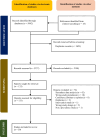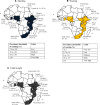The Prevalence and Determinants of Undernutrition Among Infants and Children Aged 6 Months to 5 Years in Sub-Saharan African Countries: A Systematic Scoping Review
- PMID: 39760760
- PMCID: PMC12166183
- DOI: 10.1093/nutrit/nuae189
The Prevalence and Determinants of Undernutrition Among Infants and Children Aged 6 Months to 5 Years in Sub-Saharan African Countries: A Systematic Scoping Review
Abstract
Objective: To explore the prevalence and determinants of undernutrition among infants and children aged 6 months to 5 years in sub-Saharan African countries.
Background: Despite substantial progress over the past 20 years, undernutrition has remained an alarming global challenge. Sub-Saharan Africa is the only region where the prevalence of stunting in children younger than 5 years has significantly increased. This study seeks to update the evidence on the prevalence and determinants of childhood undernutrition in this vulnerable region.
Methods: This systematic scoping review was conducted following the 2018 Preferred Reporting Items for Systematic Reviews and Meta-Analyses (PRISMA) extension for scoping reviews. Five electronic databases were searched on December 14, 2022, with no date or language restrictions. Primary studies presenting evidence on the prevalence and determinants of childhood undernutrition among infants and children aged 6 months to 5 years were included. Data on the prevalence of stunting, wasting, and underweight, and on determinants of undernutrition were extracted, described, and compared with national survey data.
Results: A total of 59 publications from 11 countries were included, with most studies conducted in Ethiopia (n = 38) and Tanzania (n = 7). Stunting prevalence ranged from 8% to 64%, wasting prevalence ranged from 1% to 58%, and the prevalence of underweight ranged from 2% to 63%. The most frequently reported determinants of undernutrition were the child's age (>24 months), male sex, maternal illiteracy, diarrhea or illness in the past 2 weeks, low household socioeconomic status, or living in a larger household (n > 4 members). Overall, 56% of the included studies reported higher stunting prevalence, 60% reported higher wasting prevalence, and 57% reported a higher prevalence of underweight than reported by relevant national surveys.
Conclusion: The prevalence of childhood undernutrition reported by primary studies is often higher than that reported by national surveys. Several immediate and underlying determinants influence childhood undernutrition. Future research should incorporate the findings from primary research to develop holistic, multistrategy approaches to address childhood undernutrition in sub-Saharan African countries.
Keywords: stunting; sub-Saharan Africa; under-fives; underweight; wasting.
© The Author(s) 2025. Published by Oxford University Press on behalf of the International Life Sciences Institute.
Conflict of interest statement
None declared.
Figures



Similar articles
-
Stunting, Wasting and Underweight in Sub-Saharan Africa: A Systematic Review.Int J Environ Res Public Health. 2017 Aug 1;14(8):863. doi: 10.3390/ijerph14080863. Int J Environ Res Public Health. 2017. PMID: 28788108 Free PMC article.
-
Risk factors for undernutrition and poor growth during the first 6 months of life in sub-Saharan Africa: A scoping review.Clin Nutr ESPEN. 2025 Aug;68:309-318. doi: 10.1016/j.clnesp.2025.05.019. Epub 2025 May 16. Clin Nutr ESPEN. 2025. PMID: 40383255
-
Nutritional Status of Under Five Children in Ethiopia: A Systematic Review and Meta-Analysis.Ethiop J Health Sci. 2017 Mar;27(2):175-188. doi: 10.4314/ejhs.v27i2.10. Ethiop J Health Sci. 2017. PMID: 28579713 Free PMC article.
-
Joint modelling of anthropometric child undernutrition indicators to identify their risk factors in Bangladesh: evidence from the Multiple Indicator Cluster Survey (MICS) 2019.BMJ Open. 2025 Jul 11;15(7):e092536. doi: 10.1136/bmjopen-2024-092536. BMJ Open. 2025. PMID: 40645633 Free PMC article.
-
Effects of armed conflicts on childhood undernutrition in Africa: a systematic review and meta-analysis.Syst Rev. 2023 Mar 15;12(1):46. doi: 10.1186/s13643-023-02206-4. Syst Rev. 2023. PMID: 36922839 Free PMC article.
References
Publication types
MeSH terms
LinkOut - more resources
Full Text Sources
Medical
Miscellaneous

